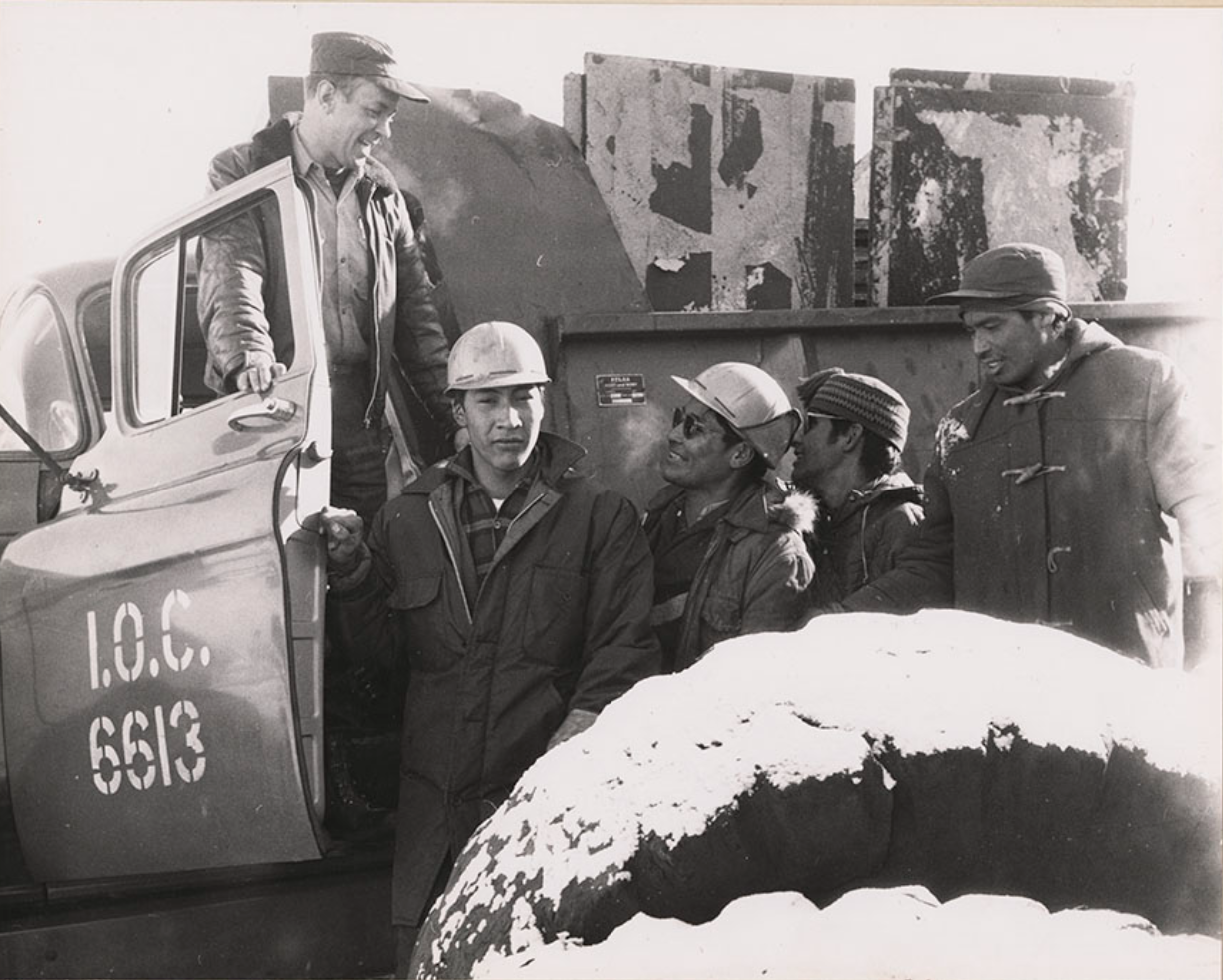Photo: Innu surface workers employed by the Iron Ore Company at Schefferville, Québec. Library and Archives Canada, R216, RG10, Box number: 3673.
By Steven High
Forty years ago this summer, the Cleveland-based Iron Ore Company of Canada closed its open pit mine in Quebec’s far northeast, putting the future of the town of Schefferville into doubt. Most of the housing in the town of 2,500 was owned by the departing company as was the long railway line south to Sept-Iles, the only land-link to the outside world. While most industrial closures receive little public attention outside of the immediate locality or region, Schefferville became front page news across Canada for weeks, even years.
What explains this sustained interest?
There are two main reasons. First, the head of the IOC was Brian Mulroney, who had previously run unsuccessfully for the federal Tory leadership and was expected to run again shortly. While many pundits initially thought the Schefferville closure would kill his chances, Mulroney proved fiercely adept and effectively flipped the narrative. Instead of being the man who killed a town, Mulroney presented himself as its champion – going on the offensive against provincial and federal governments who extracted royalties and taxes from the region but invested little. He almost single-handedly forced Quebec to promise not to close-out the town. As long as the town withered but didn’t die, Mulroney couldn’t be blamed for killing it.
After months of uncertainty, and only hours before Mulroney flew on his private jet to Winnipeg for the Tory Convention that launched the leadership race, Mulroney negotiated a sweetened close-out agreement with the United Steelworkers. In so doing, he had transformed Schefferville into a positive for his career. He subsequently won the leadership race and the next election, becoming Canada’s prime minister in 1984. As prime minister, Mulroney imposed privatization and austerity, rolling back unemployment benefits and clawing back severance pay from displaced workers. He then negotiated free trade agreements with the United States and then Mexico, which triggered massive industrial restructuring as the branch plants of US-based multinationals were now largely redundant.
During these years, “No More Scheffervilles” became a popular protest slogan.
The second reason why the Schefferville mine closure drew national attention was its symbolic importance in the northward expansion of Quebec’s industrial frontier during the post-war boom. Thus, when Quebec politicians of the era promised prosperity in the 1950s, they regularly invoked iron ore mining and the town of Schefferville. With the closure announcement, a Quebec parliamentary commission was named to inquire into the fate of the town, taking the unprecedented step of holding hearings outside of the capital city. In the transcripts, we hear from the company, union, and area residents, including the Naskapi and Innu communities – the Indigenous peoples who have called this area home for millennia.
By the time that the parliamentary commission visited Schefferville in February 1983, only about one in four houses was still occupied, leaving some streets entirely abandoned. The language of colonization permeated the two days of hearings, with the regular invocation of Quebec’s version of the white pioneer narrative. For example, a group of young white francophones who were born or raised in the town said: “We know, and you know, that we are the guardians of the frontier. Schefferville contains not just an iron mine, but there is also the presence of a people ‘typiquement québécois.’” This articulation of their identity was defined very much against Indigenous people. Yet their presentation resonated with the elected representatives of the governing Parti Québécois.
By contrast, the response of members of the national assembly (MNAs) to the two Indigenous presentations was telling, as there was no recognition that Indigenous people were economically impacted by the mine closure announcement even though dozens worked for the IOC. Liberal MNA John Ciaccia went so far as to dismiss their concerns as irrelevant to the task at hand: “I don’t think that we should permit Indigenous people to feel obligated to make representations, as they have done before this parliamentary commission, which was mandated, not to look into the problems of Indigenous people, but to look at the problems of Schefferville citizens.”
What is even more telling is that Schefferville’s white population, already in sharp decline, dropped off a demographic cliff during these months. By the time that the parliamentary commission arrived, there was already an Indigenous majority in the area. Soon it would reach 80% as white miners and their families returned south. Yet the parliamentary commission continued to equate the town with its white residents. When the Innu and Naskapi leadership challenged this ethno-centrism, their presence at the hearings was questioned.
The Schefferville case is therefore a reminder that industrialism was bound up in wider racialization processes and that deindustrialization was likewise racialized.
For more on the Schefferville story, check out my recently published peer-reviewed article “ ‘With Iron We Conquer’: Deindustrialization, Settler Colonialism, and the Last Train out of Schefferville, Quebec,” Canadian Historical Review 104, 1 (March 2023), 50-75 or write directly to me for a copy (steven.high@concordia.ca).
Steven High is a professor of history at Concordia University and is the director of the Deindustrialization and the Politics of Our Time research project.





